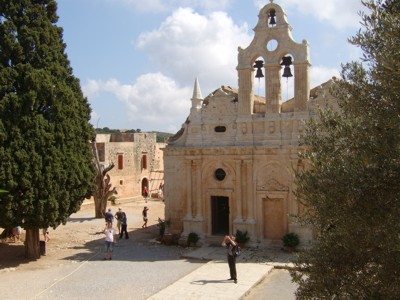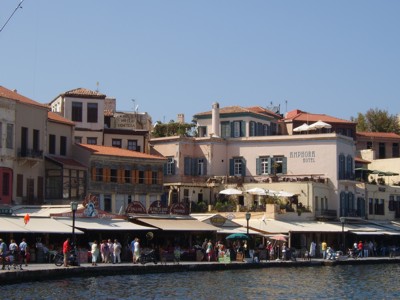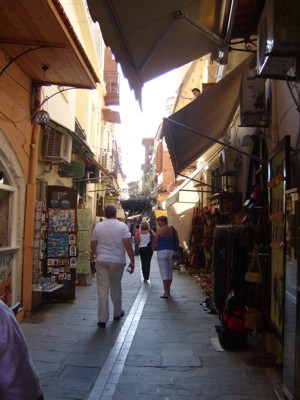I'm sitting on my bed eating Cadbury's Dairy Milk. I'm on my bed because the hotel room has no chair of a height compatible with any table. I'm scoffing English chocolate because I don't want to pay 25 Euros to eat in the hotel restaurant. If I liked seafood or chicken I'd be gorging myself in there, and good though the desserts are I don't want to get diabetes from eating 25 Euros worth of them. So here I am, eating the supply of chocolate I always take with me for situations such as this.
Last night, I visited guest relations and asked if there were any tours available for today. There were two: one to two places to the east, neither of which sounded particularly enticing, and one to Western Crete. The guest relations woman, I correctly deduced, was from Chania (in Western Crete) herself, which in part explained why she was describing it as if it were some kind of paradise. There was one slot left on the trip, so I booked it. The guest relations woman gave me the business card of her brother, who runs a shop in Chania called Fredi that sells clothes for teenage girls. Buying some stuff for my daughters from this shop was to be my quest; buying some tourist tat from the gift shop next door to Fredi was a secondary quest.
At 8:20, I caught the bus. I got a nice seat next to a window with a view unobstructed by curtains. I was on the right-hand side of the bus, so I wouldn't get cooked by the sun.
An hour and fifteen minutes later, the bus had picked up all the other passengers. It was indeed full. Late-pickups were having to split their groups up. I found myself sitting next to an immense English woman who wore shoes that made her feet look like pigs' trotters (alternative: her feet did actually look like pigs' trotters and the shoes were a ruse to trick people into thinking it was simply her footware choice that made them appear so). Anyway, she was sweaty and bulky and her mother was sitting two seats ahead of her.
We stopped for a coffee/toilet break, which I used to buy an ice cream — the Greek equivalent of a Magnum. I was quite pleased that I had chosen to wear a white shirt, because it was pretty darn hot out in the sun. I bit into the ice cream, a slab of chocolate immediately fell off, and it hit me on the chest on its way to the ground. I can still see its outline on my shirt even now. Next time, I'm buying the white chocolate version...
Back on the bus, I had a decision to make: should I keep my great seat with its splendid window views, or should I offer to give it up so the beast woman sitting next to me could sit with her mother? I finally decided to be kind, and did the switch. As soon as I did it, three other people were shamed into swapping seats to bring separated couples next to each other. This is the kind of decisive action trend-setting that won me an award for game design. No, really.
The new person I was sitting next to was Russian. She spoke no English, Greek, German or French (the languages of everyone else on coach), and whenever we stopped and were told when to get back to the coach I had to write it down for her.
Our first official sight was Arkadi Monastery, "the most famous monastery in Crete".
Now the way that it was always described this way soon roused my suspicions. It wasn't the most ancient monastery, or the most beautiful monastery, or the most important monastery, it was the most famous monastery. So why was that?
As we got closer, the tour guide explained fragments of its story (switching between German and English at key points to preserve the tension). It turned out that during Crete's war of independence from the Turks, thousands of Cretans holed up there. The Turks came along and destroyed the ancient frescoes, then they went away, but the Cretans remained. Then it happened again in German. Then the Turks sent along a big gun and blew up the gate and pounded the church. Then they did it again in German.
OK, so no frescoes, no gate, large pieces of church reduced to rubble ... a real tourist trap in the making.
Finally, rather than surrender to the Turks, the Cretans all gathered in the gunpowder magazine and blew themselves up. The gunpowder magazine and the floor above and a good deal of the wall outside went with them. According to historical records, 3,000 Cretans died in the explosion, although given there was barely enough room for a tenth of that number in the area concerned I strongly suspect there may be some exaggeration involved. Anyway, the Cretans thus won a moral victory if not a military one; the story spread an inspired other Cretans to revolt against the hated Turks, and this is why the monastery is the most famous in Crete.
It's also why it looks like a film set for the Alamo:

When they said this was a tour of Western Crete, I wasn't expecting it to be that kind of Western...
It cost 2.50 Euros to look inside the church. Or, if I'd know that no-one ever checked the tickets, free. I'm guessing the signs that prohibited photography were there to spare the monastery's blushes — I wasn't the only person to notice that the silver crown on the icon of Saint Constantine was held in place by two pieces of chewing gum...
From Arkadi Monastery, we went to Chania, the second-largest city in Crete; its population is 100,000. The final stop on our trip, Rethymno, is the third-largest city in Crete; its population is 40,000. The largest city in Crete is, of course, Iraklion.
Yes? And its population is..?
She never told us! Damn those tour guides, why do they always do that? I bet she told the Germans...
The old town of Chania was really, really nice. There's a Venetian harbour surrounded by lots of narrow streets packed with little shops selling all sorts of interesting items. It reminded me of Mykonos harbour, but the streets were more like Rhodes. It's very picturesque:

The tour guide took us to a restaurant where, as a special surprise, we were offered 15% discount!
No surprise to me: tour guides seem to have a habit of taking busloads of tourists to eating places where the owner gives them a free meal or some other kickback in return...
I did have the name of a restaurant from the guest relations woman in the hotel, which she said was much better than the tourist places and was where her family ate. I couldn't find it, though, despite her insistance that I didn't need its address because it was next to the old harbour. Yes, as are 40 other restaurants...
Anyway, I wasn't planning on eating much anyway because you never get to see much of a place if you spend half your allotted time waiting for a waiter (that job title is so the wrong way round), so I bought a sandwich and struck out. Aided by a map provided by the conference, I tracked down the Fredi store to buy my daughters some "elegant casuals".
Hey, just a moment! It only sold clothes for men! And unless the guest relations woman's brother is in his 50s, that wasn't him there.
Bah! All Cretans are liars...
The shop next door to Fredi was indeed a souvenir shop, but it wasn't tat. Indeed, it had some really nice stuff in that I bought for my kids. I don't know how much business they do there, but when I said I wanted to pay by credit card the guy pulled out one of those old carbon-paper imprint machines from the days before credit cards had magnetic strips. I paid cash instead...
So, having failed my quest but satisfied my subquest, I spent a bit more time looking around and headed back to the coach. Then, it was on to Rethymno.
Rethymno has a nice old town, too, although it's not as big as Chania's. Here's a sample street:

It has a harbour, too. I couldn't tell whether it was picturesque, though, because, well, of this:

I thought it was some kind of restaurant, but no, it's actually seaworthy and they take it out on day trips. Apparently, the pirate Barbarossa raided the town several hundred years ago just after the Venetians had finished building a wall. The wall thus proven inadequate, they built a castle. This lasted until tested by the Turks, who flattened it in no time and built a domed mosque where it stood. I'd have taken a picture of it except the Russian woman had the window seat so I couldn't. Anyway, because Barbarossa sacked the town, someone from our own time seems to have thought it a bright idea to build an eyesore and moor it in the harbour.
Talking of eyesores, our tour guide kept telling us that Rethymno has the tallest minaret in Crete. She gave us explicit directions on how to find it, and sounded quite proud. I'm not entirely persuaded that "Come to Crete and see the tallest minaret in Crete" is as powerful an endorsement as she believes, but hey, if I'm 50 metres from it, why not?
This is what it looks like:

Looks as if the Cretans aren't quite over that whole Turkish occupation deal just yet.
After Rethymno, we headed back and dropped people off at their hotels in reverse order from which they were picked up. This area east of Iraklion is so over-developed that huge hotel villages occupy sites at the end of roads which are pretty well single carriageway for coaches. Some aren't wide enough for two cars to pass each other, which makes the decision of some people to park there all the more bemusing. On several occasions the bus driver had to honk to get someone to move their vehicle, and in one place had to reverse almost 100 metres so a bus coming the other direction could squeeze past. I finally arrived back at my hotel 11 hours 45 minutes after I left.
Summary: Crete is like Cyprus, but better. I'd certainly come again.
Damn. I'm out of chocolate. Still, it's whatever the time is and whatever the temperature is, so ... oh, you know the drill.